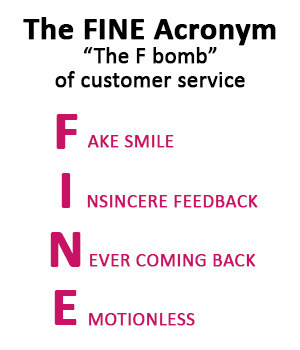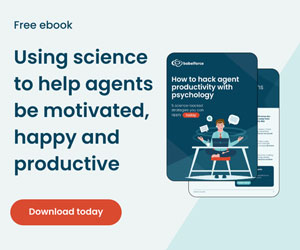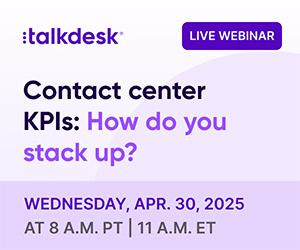Is the relationship between customer effort, emotion, and resolution tightly woven into your CX strategy, or is it always being sidelined by the next big thing?
If it’s the latter, it’s time to think again, as our Editor, Megan Jones, brings you the latest insights on customer effort, emotion, and resolution – from Brad Cleveland, Katie Stabler, and Shep Hyken, alongside highlights of the NICE International Happiness Index 2024 – to show you how getting this right really can make or break the customer experience.
10 Home Truths About Customer Effort, Emotion, and Resolution
Here’s a round-up of examples and insights that will make you think twice about the role of customer effort, emotion, and resolution in your contact centre…
1. You Really Never Want to Hear Your Customers Use ‘The F Bomb’

Here’s some food for thought!
The next time a customer says “it’s fine” – think about it as “The F bomb” of customer service. As Shep Hyken says, this can be presented as the acronym FINE:
- F is for… Fake smile
- I is for… Insincere feedback
- N is for… Never coming back
- E is for… Emotionless (Quite frankly, “I don’t care about you anymore”.)
You really don’t want your customer service to ever be “Just FINE!”
2. Stop Getting Distracted by the Hype!
Unwittingly, many leaders don’t put an emphasis on customer effort like they should, as Brad Cleveland explains:
“When leaders get stuck into supporting objectives, such as internal efficiency gains, they can take their eyes off the prize of decreasing customer effort.

“It’s all too easy to be distracted by all the noise and hype of the latest technology, as is happening with AI right now, and forget to put the customer at the heart of what you’re trying to do – when really you’ll make life easier for your customers by keeping them at the centre of every decision that you make.”
How do you keep the focus on customer effort?
It can help to use this framework of the 10 customer expectations [source: Brad Cleveland, Contact Center Management on Fast Forward]:
- Be available (be accessible)
- Treat me courteously
- Be responsive to and anticipate what I need
- Do what I need promptly
- Be well-trained and informed
- Tell me what to expect
- Keep your promises
- Do it right the first time
- Follow up as needed
- Be socially responsible and ethical
For five key questions to help you assess whether or not you are managing customer expectations, read our article: How to Manage and Exceed Customer Expectations – With Examples
3. You Only Get 2 Chances Before a Customer Switches to a Competitor!
There is an expectation that brands set with their customers via marketing campaigns and adverts – and it doesn’t matter if that’s B2B or B2C – they all show images of happy customers, of friendly people working for them, and (most critically) promises that they deliver great service.
But then what happens? The reality of the experience too often lets them down, customers are disappointed, and the contact centre has to pick up the slack!
The worst part? Some customers are willing to try again, but they don’t give quite as many chances as they used to, as research from The State of Customer Service and CX (2024) report shows you get just 2.2 chances before a customer switches to a competitor!
4. The Very Best Leaders Are Proactive and Creative About Reducing Customer Effort
The most admirable customer service leaders are the ones who identify the effort customers don’t even talk about, taking a proactive stance to highlight something as an offender and eradicate it!
It’s a very forward-thinking approach, as Katie Stabler shares in this example:

“The online grocery store Abel and Cole springs to mind here, as they proactively eradicated customer effort by partnering with a flower company called Freddie’s Flowers – mainly for sustainability reasons, to put less trucks on the road, etc…
“But when I say they took away the effort you didn’t know you had, all your ordering is now all in one place, so even though it’s two separate companies, everything is combined.
“Your deliveries are on the same day, so you don’t have to wait around for two separate deliveries that week. So it wasn’t that it felt like an effort and customers complained BUT suddenly putting them together has made life easier for customers.”
5. Your Agent’s Job Isn’t Just to Fix the Problem – It’s About Restoring Confidence Too!
Whenever there’s any conflict, a complaint, or any negative issue, the agent’s goal shouldn’t just be to fix the problem, but to also restore customer confidence, as Shep Hyken explains: “The goal is not to win an argument… It’s to win the customer!”
Here are 5 key steps agents can follow to successfully manage a conflict or a complaint:
- Apology: “I’m really sorry that happened to you.”
- Acknowledgement: “I get it. If that happened to me, I would be upset as well.”
- Discuss what the resolution is: Can it be fixed on the spot? Is it a process that’s going to take a while?
- Take ownership and accountability: It’s an attitude of “I’m here to take care of you”. Empower your agents to be able to make good decisions, teach them that they don’t have to have all the information BUT they need to know where to go to get the information.
- Urgency: “How quickly can we get this done?”
6. Nine out of 10 People Are Willing to Pay More for a Customer Experience That Leaves Them Feeling Happier
To quantify the impact that an experience with a brand has on consumers, NICE commissioned the International Happiness Index, surveying over 4,000 people from across the US and the UK about their customer service experiences, and how happy – or not – these made them feel.
Here are just some of the key findings:
- The opportunity for purpose-built AI to enhance customer experience is enormous. 78% of people think using digitization and AI in customer service can make them happier.
- Consumers already understand the benefits AI can bring to their lives. The number one benefit of AI in the eyes of consumers is resolving issues faster (selected by 41%) followed by not having to repeat themselves (36%).
- It really does pay to be nice. Nine out of 10 people (91%) are willing to pay more for a customer experience that leaves them feeling happier.
- Making customers happy doesn’t even need to cost businesses more. The majority of consumers (67%) are just as happy when receiving friendly interactions as they are freebies or discounts.
7. Ignoring Your Customers’ Problems Will Only Make Them Leave!
Customers often don’t come back because they try to let the company know there’s a problem and then the company simply doesn’t return the effort and resolve the issue – sometimes they don’t even respond!
Research from The State of Customer Service and CX (2024) report shows that 75% of the customers who made the effort to tell a company about a problem – and didn’t get a response – would leave!
Are you creating this friction with your customers?
8. You Must Always Own the Experience – Even When Things Go Horribly Wrong (A Lesson Learned From Starbucks)
Do you recall the crisis Starbucks had a few years ago?
It was an upsetting and high-profile event, but Howard Schultz, who was CEO of Starbucks at the time, understood a thing or two about customer emotion, as Shep Hyken explains:

“As the news broke, Schultz immediately made a statement to take control of the situation and say, ‘I don’t know what actually happened, but I’m going to take an all-night flight to Philadelphia, I’ll be talking to the manager, I’ll be talking to the police, and I’m going to make a formal statement to the public once I know what’s going on.’ And that’s exactly what he did!
“He also made huge apologies and said we’re going to try to make sure it never happens again. He owned the experience and took immediate action, part of which was to shut down the entire North American operation and put all the employees in those stores through video-based training on sensitivity and understanding.”
This is a great example of a leader owning the customer experience, understanding the gravity of emotion, and doing what he said he would to help make things right.
9. Your Customers Fall in Love With Your Processes – Not Just Your People
When you succeed in creating an easy, frictionless, intuitive process that customers get comfortable with, they don’t want to take a chance on anybody else!
After all, when customers say, “I love doing business with them”, often “them” refers to a process – not just a person. There’s a good percentage of customers that would even say, “this is what’s keeping me here”, and this can really work in your favour, as Shep Hyken explains:
“If you’re going to fly with a different airline and you go online to book your ticket, the process for returning customers is probably intuitive, easy, and, frictionless.
“However, if you’re used to one airline’s way of doing it and you switch to another, there’s a little bit of pain in initially learning the way their booking system works. That’s the friction, and if you don’t like experiencing that pain, quite simply, you just stick with what you know.”
Not sure where to start? Read our article Key Signs of Broken Processes (and How to Fix Them) for expert advice on the classic broken processes to look out for, signs to spot them in your contact centre, and fix them.
10. …And Seriously Never Expect Customers to Call YOU Back for an Update on a Problem
A distinct lack of proactive customer communication can also excalate into a truly awful customer experience, as Katie Stabler explains:
“Long story short, I bought some expensive earbuds that didn’t work, they replaced them, but they didn’t work again, so I decided I’ll just have a refund – but it took over 40 days to process.
“This was made all the worse by the fact that there wasn’t a single bit of proactive communication, so I was contacting them every few days to ask, ‘what’s going on and can I have an update please?’
“They would tell me that there would be an update in 24 to 48 hours, but then no one would contact me after 48 hours, so I would contact them again, and on one of the occasions I said to the agent, ‘You keep promising me that I’ll get an update in 48 hours and I don’t have to contact you’ and their response was ‘Oh no, we won’t contact you. We were telling you there will be an update in 48 hours – and you can contact us to get that update.’
“Talk about effort for your customers and lack of care!”
With thanks to the following contributors:
- Brad Cleveland, a well-respected consultant, keynote speaker, and course instructor
- Katie Stabler of CULTIVATE Customer Experience by Design
- Shep Hyken, Chief Amazement Officer (CAO) at Shepard Presentations LLC
- NICE International Happiness Index 2024 – Click here to download the report
If you are looking for more ways to take your customer experience to the next level, read these articles next:
- 15 Tips for Building Emotional Intelligence in Customer Service
- How to Calculate Customer Effort
- 3 Ways to Measure Customer Emotion in the Contact Centre
Author: Megan Jones
Reviewed by: Xander Freeman
Published On: 21st Aug 2024
Read more about - Customer Service Strategy, Brad Cleveland, Customer Effort, CX, Emotion, Katie Stabler, NICE, Shep Hyken, Top Story






































